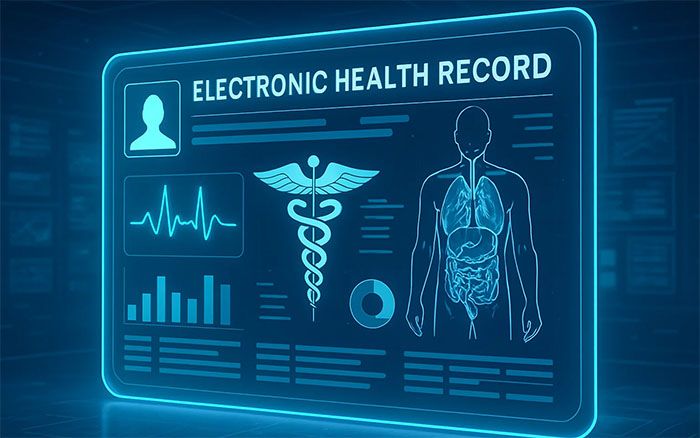3 Ways Smart Data Management Can Support Your Clinic
This piece was contributed by Mary Kuchenbrod, VP of Data Operations at Arcadia, an analytics platform for data-driven healthcare organizations. To learn how you can deliver faster decisions and better results using advanced healthcare analytics, visit Arcadia’s website.

The amount of healthcare data generated each year is scaling at 47%. Clinics must adapt their traditional data management processes to handle the rapidly increasing volume of patient data.
Due to the sheer scale of healthcare data, advanced approaches and tools are necessary for streamlined data collection, storage, sharing, and analysis. With strong data management, downstream analytic outputs help providers derive meaningful insights for informed decision-making. Overall, the right strategies and technologies drive improved wellness across patient populations.
In this guide, we’ll discuss how smart data management solves healthcare’s greatest data difficulties.
1. Improve Patient Outcomes
Your clinic’s top priority is its patients’ well-being, and smart data management is the way to achieve that. Readily available and accurate data is key to informed decision-making, directly impacting care delivery outcomes.
Effective data management supports clinical decision-making at every touchpoint, including:
- Diagnosis: Clinicians must have access to comprehensive data for a holistic view of a patient’s health needs. Collecting and centralizing real-time data enables providers to develop precise diagnoses and timely intervention plans.
- Treatment: Comprehensive data allows clinicians to design tailored treatment plans or leverage tools that automate treatment plan proposals. For example, Arcadia’s care management software guide explains this technology facilitates informed intervention strategies by streamlining treatment planning, medication management, and other aspects of patient management.
- Follow-up: Effective data management empowers providers to identify patients at risk of complications or long-term conditions to implement proactive care. Data-driven patient communication increases the likelihood that patients adhere to care plans and stay involved in their care journeys.
Takeaway: Implement a system for organizing existing data and supporting patient interactions at each touchpoint. Look for a solution purpose-built for analytics, including predictive analytics to support future touchpoints with proactive care.
2. Enables Data Interoperability
Proper data management ensures that information is easily accessible by the right parties. Clinicians must collaborate to provide whole-person care that addresses all of a patient’s needs, and this is only possible when information is unified under a centralized database.
Cloud-based data storage systems enhance care coordination by facilitating simple and secure data interoperability. The optimal storage solution should allow for:
- Data organization: Online storage solutions aggregate patient records, eliminating the need for chart chasing and providing timely access to critical data.
- Scalable growth: As clinics grow, data volume will inevitably increase. Cloud-based systems can adapt accordingly, accommodating increasing data loads without major infrastructure changes.
- Robust analytics: In addition to simply storing data, an effective solution should support informed decision-making by extracting actionable insights. This allows clinicians to use aggregated EHR data from multiple sources at the point of care, leading them away from reactive medical treatments and toward preventive medicine.
As a result, these systems facilitate:
- Enhanced care collaboration: An organized repository stores all usable healthcare information from EHR solutions, insurance claims, lab databases, and other critical data sources. With organized data, clinicians can seamlessly share and problem-solve through transferable insights.
- Efficient workflows: Readily accessible data enables employees to make the best use of their time. With greater efficiency, clinicians can improve the patient experience by reducing wait times and minimizing record-keeping errors, and clinics can avoid staff burnout caused by hefty task loads.
- Patient engagement and retention: Cleaner file management empowers providers to bridge communication gaps, streamline patient interactions, and deliver personalized care. This fosters patient trust, increasing satisfaction and loyalty to their providers.
Takeaway: Evaluate your current data storage system to identify any gaps in interoperability. Implement new systems or integrate existing ones to unify information into a central repository and improve care coordination.
3. Enhances Data Integrity
A substantial benefit of strong data management is that it builds trust in your organization’s data. The right precautions ensure clinicians have reliable and accurate patient information, empowering them to make confident care decisions.
After establishing a scalable data storage solution and improving data sharing, clinicians must implement robust measures to ensure data quality remains high over time. A strong portfolio of safety checks should include:
- Continuous monitoring: Healthcare data changes constantly. The best ongoing practices assume that something will go wrong, flag it when it does, and isolate that data from moving downstream and negatively impacting your operations. As a result, strong data management allows clinicians to address issues before they escalate.
- Disaster recovery and backups: A comprehensive data restoration strategy ensures clinicians can restore critical patient data after a cyberattack or hardware failure. This way, your clinic can continue operations swiftly, minimizing disruptions to your workflows and patient care.
- Root cause analysis: Identifying the underlying causes of data inconsistencies or errors enables care teams to maintain data integrity. Clinics can then ensure the long-term reliability of patient data by preventing recurrence through data standards.
Takeaway: Focus on quality in your data management approach, creating a system that prioritizes accurate and consistent data entry. Address any existing errors and take proactive steps to avoid repeating the same mistakes.
4. Smart Data Management Requires Strategic Planning
Healthcare organizations must adopt strong data management tools and techniques to set the pace for improved workflows and outcomes. However, the key to effective data governance in healthcare is developing and implementing a well-structured plan for the future.
Work with your team to determine your data management approach and research the tools needed to execute it. With a strategic approach and the right toolkit, your team can improve its efficiency and increase capacity while minimizing risk.
















